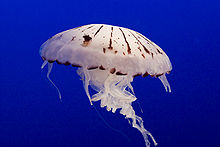- Chrysaora colorata
-
Chrysaora colorata 
Purple-striped jelly (Chrysaora colorata) Scientific classification 
Kingdom: Animalia Phylum: Cnidaria Subphylum: Medusozoa Class: Scyphozoa Order: Semaeostomeae Family: Pelagiidae Genus: Chrysaora Species: C. colorata Binomial name Chrysaora colorata
Russell, 1964The purple-striped jelly (Chrysaora colorata, formerly Pelagia colorata) is a species of jellyfish that exists primarily off the coast of California in Monterey Bay. The bell (body) of the jellyfish is up to 70 cm (27.6 inches or 2.3 feet) in diameter, typically with a radial pattern of stripes. The tentacles vary with the age of the individual, consisting typically of eight marginal long dark arms, and four central frilly oral arms. It is closely studied by scientists due to not much being known about their eating habits.[1]
Often cancer crabs make home in the jellyfish and eat the parasitic amphipods that feed on and damage the jelly.[2]
Description
The Purple Striped Jellyfish is also known as Chrysaora Colorata and the Mauve Stinger. When it is extremely young, it has a pinkish color and its tentacles are long and dark maroon. At the adult stage the dark maroon color of the tentacles starts to fade and the purple appears as stripes on the bell. At a young age the adults' four frilly oral arms will become longer. When the jellyfish starts to get older the tentacles thicken and the purple stripes start to darken and the tentacles start to look pale, its oral arms like to disappear. They are known to feed on a variety of organisms including Cladocera, Appendicularia, Copepoda, Hydromedusae, Siphonophpra, and fish eggs. When the prey touches a marginal tentacle of the jelly, stingers are immediately discharged to paralyze prey and marginal tentacle bends inward to the nearest oral arm. The oral arm is used to transport prey to the gastrovascular cavity (GVC) and to catch motionless prey. The sting of this jellyfish is extremely painful to humans but is rarely if ever fatal.
Diet
Its diet consists of zooplankton, including copepods, larval fish, ctenophores, salps, other jellies, and fish eggs.[2]
References
- ^ The JelliesZone - Jellyfish & Other Gelatinous Zooplankton: Chrysaora colorata, accessed March 15, 2008
- ^ a b "Purple-striped jelly". Monterey Bay Aquarium. http://www.montereybayaquarium.org/animals/AnimalDetails.aspx?enc=n3f4wmcSJaNx01oyfCKuWA==. Retrieved 3 April 2010.

This cnidarian-related article is a stub. You can help Wikipedia by expanding it.
